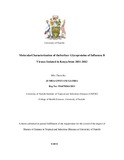| dc.contributor.author | Jumba, G Gloria | |
| dc.date.accessioned | 2015-09-07T10:06:40Z | |
| dc.date.available | 2015-09-07T10:06:40Z | |
| dc.date.issued | 2015 | |
| dc.identifier.uri | http://hdl.handle.net/11295/90691 | |
| dc.description | Thesis | en_US |
| dc.description.abstract | Influenza B viruses can cause severe respiratory disease and occasionally epidemic outbreaks.
Vaccination is the mainstayof prevention and reduces disease impact. Vaccine efficacy is
determined mainly by the degree of haemagglutinin (HA) antigen matching between the vaccine
and circulating strains. Neuraminidase inhibitor (NI) antivirals are important for prophylaxis and
treatment of severe cases of influenza disease. However, mutations in the two major surface
proteins, hemagglutinin (HA) and neuraminidase (NA) can cause the virus to escape host
defenses leading to failure of the host immune system to recognize the viruses as well as failure
to antiviral therapy. Due to these mutations, antibodies produced against these viruses may
become ineffective against anew emergent viral strain or the changes may lead to antiviral
therapy failure. This is further complicated by the existence of the two distinct lineages.-
B/Victoria/2/87-like viruses and B/Yamagata/16/88-like viruses- that continue to co-circulate
globally in the human population. These viruses exist as independent lineages and antibodies
against one lineage are generally not cross-protective. The World Health Organization
(WHO)Strategic Advisory Group of Experts which issues vaccine component recommendations
to be included in the annual influenza vaccine formulations recently revised the seasonal vaccine
composition from atrivalent to an alternative containing quadrivalent components. Thus,
information about lineage of circulating influenza B viruses is important for determination of the
appropriateness of either a trivalent or a quadrivalent vaccine composition.
The objective of this study wasto investigatethe molecular characteristicsof influenza B viruses
that circulated in Kenya from 2011-2012 and the appropriateness of antiviral therapies including
the WHO vaccine recommendationsusing bioinformatic analyses on nucleotide sequences of NA
and HA glycoproteins of selected virus isolates.
Nasopharyngeal swab specimens obtained from patients meeting WHO case definition for
influenza-like-illness (ILI) were screened by real-time PCR for influenza B viruses. Positive
samples were inoculated onto monolayers of Madin-Darby Canine Kidney (MDCK) cells and the
lineages of the isolates determined by hemagglutination inhibition assay (HAI). To confirm the
lineages and susceptibility to neuraminidase inhibitor drugs, HA and NA gene segments of
selected isolates were amplified by conventional PCR, sequenced and analyzed using
bioinformatic tools. The isolates were also tested for phenotypic antiviral susceptibility.
The findings of this study showed that influenza B viruses that circulated in the study period
were B/Brisbane/60/2008-like belonging to the B/Victoria/2/87 lineage. Thus the WHOrecommended
vaccine for both the Southern and Northern hemispheres was appropriately
matched in the influenza B component and was protective in Kenya. In addition, the influenza B
viruses in circulation were all susceptible to Oseltamivir and Zanamivir drugs thus indicating the
appropriateness of these drugs used in the treatment of Influenza B in Kenya. No positive
selection was observed amongst the codons of HA and NA genes in the Kenyan influenza B
viruses. Reassortment was observed in the Kenyan influenza B viruses within the NA gene
segment.
This study has underscored the importance of sustained monitoring of drug susceptibility as well
as the antigenic characteristics of the influenza viruses as a measure of epidemic preparedness. It
has also shown that the WHO recommendations for vaccine and antiviral usage cover Kenya
well and theMinistry of health should continue to implement these recommendations. Full
genome sequencing of the Kenyan influenza B viruses that circulated during the study period is
recommended to unravel the extent and probable consequences of the reassortments amongst
these viruses. | en_US |
| dc.language.iso | en | en_US |
| dc.publisher | University of Nairobi | en_US |
| dc.title | Molecular characterization of the surface glycoproteins of influenza B viruses isolated in Kenya from 2011-2012 | en_US |
| dc.description.department | a
Department of Psychiatry, University of Nairobi, ; bDepartment of Mental Health, School of Medicine,
Moi University, Eldoret, Kenya | |
| dc.type.material | en_US | en_US |

